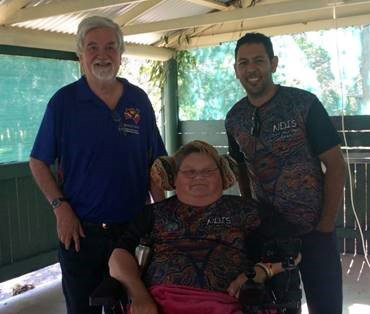My Stroke Journey by Colin Cowell
You would think with 50 years in the workforce, - 30 years of those in Indigenous health promotion at a national, regional and local level - I would have a reasonable awareness about stroke symptoms. But I didn’t.
In 2014 I was rushed to hospital by ambulance with blood pressure of 235 over 180, suffering what I now know as transient ischaemic attack (TIA).
It was a very distressing period with my face and jaw seized, but I was able to recover fully within a short period of time.
In May 2015, I had returned to Canberra from a work trip where I had spent three months visiting for rural and remote health services throughout Australia.
I was there to pack up our house before a move to Coffs Harbour. I was at home packing when I started to feel exhausted. I had some weakness in my right arm and trouble speaking.
I dismissed it, telling myself it was a virus or I was worn out from the move. But seeing me holding my weak arm and noticing my trouble speaking, my young mate, Billy, recognised these F.A.S.T. (Face. Arms. Speech. Time) symptoms and told me I was having a stroke! I went immediately to my local doctor who confirmed the diagnosis of stroke and had me in the hospital specialist stroke unit within 15 minutes.
Following extensive tests, my stroke was diagnosed. I needed surgery.
The surgery went well and while in hospital I was provided with a mountain of stroke education material including the brilliant Stroke Foundation’s ‘My Stroke Journey, and access to www.enableme.org.au.
For more than a week I lost the use of my right arm, could hardly talk, had memory loss and required assistance to walk and was very concerned about my future. Fortunately, the Stroke Unit had a range of allied health worker support with physical, speech and mental health rehabilitation support. I was released after a few weeks with an appointment for surgery in late December.
Having just sold our house in Canberra, my wife and I had moved to Coffs Harbour, so interim rehabilitation and support was transferred to local services. I was also able to join the Coffs Harbour Stroke Recovery group who were also a great support.
The Stroke Foundation support services and resources really helped my recovery. With my background in Indigenous health, when a vacancy on the Stroke Foundation Consumer Council and Board arose in early 2016, I decided to give something back and was successful in my application and subsequent appointment. I was able to serve in those roles for 18 months.
Since 2012, as the social media editor at NACCHO with 65,000 followers, I have been able to promote the great work of the Stroke Foundation to our 302 Aboriginal community controlled clinics and our thousands of supporters and stakeholders in the Indigenous health sector.
In August 2020, having just turned 70, I retired from NACCHO to take up a part time role mentoring in Indigenous business at the Coffs Harbour Innovation centre and I have the time to continue as a Strokesafe speaker / ambassador and assist on the Stroke Foundation Young Project
Finally, if I can leave you with one word or four letters of advice, remember F.A.S.T ‘cause it certainly saved my life.

